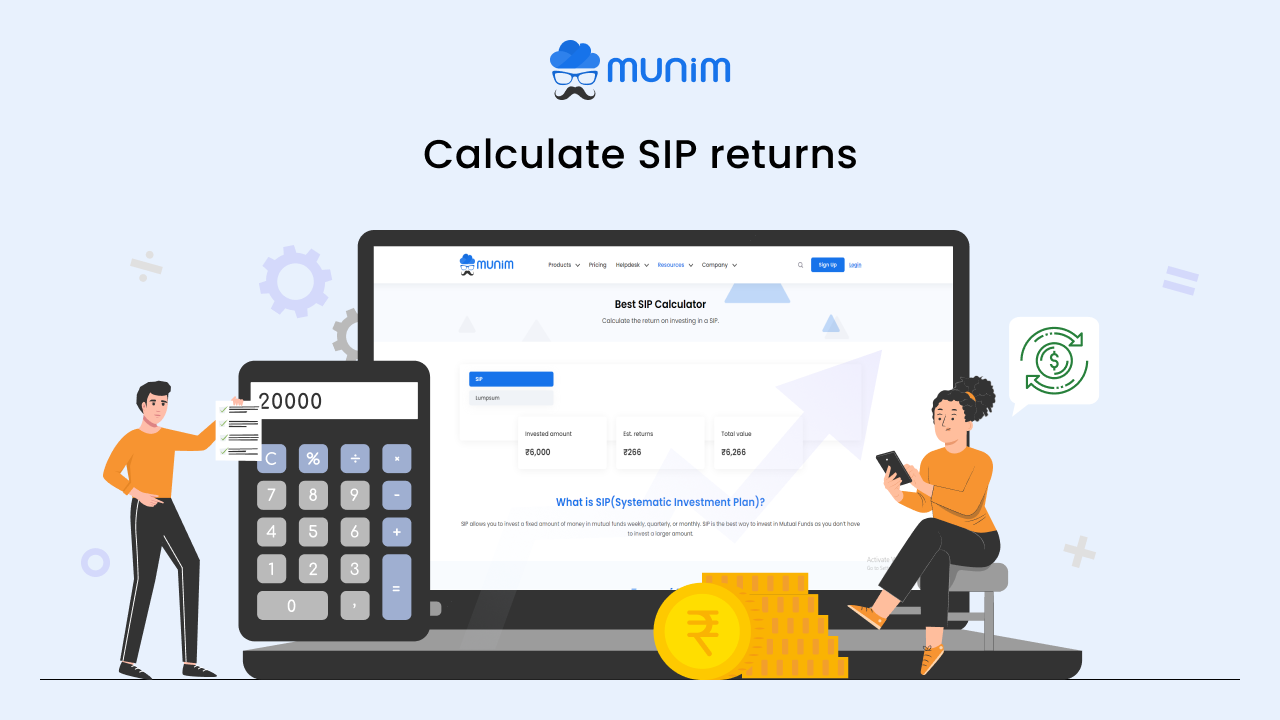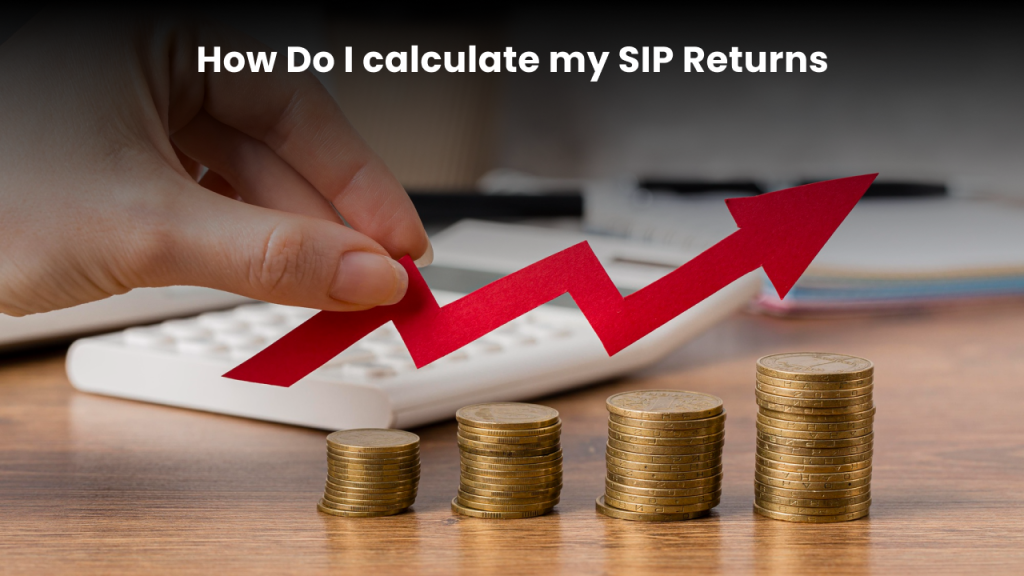How Do I Calculate My SIP Returns?

Calculating the Systematic Investment Plan (SIP) is a complete blend of SIP concepts, formulas, and factors influencing the SIP returns. Scroll down, and the article will navigate you through the process.
What is SIP?

S = Systematic
I = Investment
P = Planning
SIP is a disciplined way of investing in mutual funds. It is a popular investment strategy in the financial world. It caters to investors contributing a fixed amount regularly to an MF scheme. Generally, the period varies from weekends or months to quarters. The investors contribute to the SIP scheme regardless of market conditions. SIPs are mainly suitable for long-term wealth creation.
Key Components of SIP Formula
Investment Amount (P): The amount invested regularly in a systematic investment plan.
Number of installments (n): The total number of SIP contributions at regular intervals
SIP Return Rate (r): The expected annual rate of return on investment
Tenure (t): The entire duration of your SIP in years
Formula to Calculate SIP Returns
Here’s a compound interest formula to calculate SIP Investment
FV=P× ((1+r)n−1)/r) × (1+r)
FV= Future value of investment
P= investment amount
r= SIP return rate per period
n= total period of investment
How Do I Calculate My SIP Returns?

- Identify SIP Investment Details
- Investment Amount (p)
- P refers to the principal or fixed amount invested in SIP regularly.
- The frequency of investment is weekly, monthly, or quarterly.
- Number of installments (n)
- n refers to the frequency of contributions made weekly or monthly.
- For example, if you plan an SIP for three years and want to contribute monthly. Here’s how you calculate the installments: 3×12= 36
- It means you need to make 36 installments over three years.
- Investment Duration (t)
- It is the total number of installments or tenure of the investment in months.
- It is the period for which the investor invests a fixed amount at regular intervals.
- Convert Annual SIP Return Rate to Monthly Rate
- The annual return rate depicts the percentage increase or decrease in the investment value over a year.
- Here’s a formula to convert the yearly return rate to a monthly
Rmonthly= Rannual 12 x 100
Here,
Rmonthly = Monthly SIP Return Rate
Rannual = Annual Return Rate for SIP
- Let’s consider an example:
The annual return rate is 12%. Let’s use the formula to calculate the monthly return rate.
Rmonthly = 12%/ 12 x 100
Rmonthly = 0.12/ 12
Rmonthly = 0.01
So, we can say the monthly return rate for SIP is 1%.
- Apply the SIP Formula
- The formula to calculate SIP returns is derived from the compound interest formula.
- Here’s the formula:
FV = P x ((1+ Rmonthly)N -1)/ Rmonthly
Where:
FV= Future value of investment
P= the principal investment amount
Rmonthly= SIP return rate per month
N = The tenure of SIP investment
- Evaluate the Result
- Once the future value of the SIP investment is calculated, evaluate the results to find the SIP investment.
- Subtract the total invested amount to see the total returns.
Total Returns = FV – (P x N)
Factors Influencing SIP Returns

- Principal Amount
- The principal amount is the primary factor to calculate SIP returns.
- If the investment amount is high, it leads to larger returns depending on the market conditions.
- Tenure of Investment
- The number of contributions made play a crucial role in SIP calculations.
- The longer the tenure, the higher the contributions will be, resulting in more returns.
- Rate of Return
- The SIP return rate indicates an investment’s annual percentage gain or loss.
- It generally depends on the performance of the chosen investment scheme.
- Though a higher SIP return rate gives more returns, it comes with increased financial risk.
- Market Scenario
- The overall market conditions highly impact the SIP returns.
- While a Bullish market leads to higher returns, a bearish market might result in lower returns or losses.
- The period of SIP investment during market cycles can influence the performance of SIP.
- Mutual Fund Scheme
- It is crucial to choose a suitable mutual fund scheme.
- Multiple mutual fund schemes come with various risk factors, investment strategies, and asset allocation.
- Equity funds offer higher returns but come with higher volatility.
- Debt funds give lower returns but have stability.
- Expense ratio
- The expense ratio refers to the fees an investing firm charges for managing the investment.
- The expense ratio should be low, so that maximum returns are retained by the investor.
- SIP Frequency
- The frequency of SIP contributions is directly proportional to returns.
- Monthly contributions allow investors to buy more units when prices are low and fewer units when prices are high.
- Economic and Political Factors
- Broader economic and political factors impact market conditions and consequently affect SIP returns.
- Economic policies, geopolitical events, and fluctuating interest rates impact the performance of investment instruments.
SIP Return Calculator
Calculating returns for SIP investment manually is a tedious task. The process is long and might result in multiple errors. If you are looking for an alternative to these manual calculations, here you go:
What is an SIP Calculator?
A Systematic Investment Planning Calculator is a financial tool that assists investors in estimating the returns on their SIP investments. These calculators are widely used in MFs where investors contribute a fixed amount regularly.
Munim’s SIP Return Calculator
Munim’s SIP calculator opens the easiest gateway for investors to calculate their returns. Here’s how you can use it:
3 Easy Steps to calculate your SIP returns With Munim
- Enter the monthly investment amount
- Choose the investment tenure for your SIP
- Enter the return rate for your monthly investment plan.
Once you have filled in all the details, the screen displays the SIP returns in a few seconds.
Wrap Up
I hope you have understood the process of calculating SIP returns. If you find the process tedious, you can use an SIP calculator. Multiple SIP Return calculators are available in the market, one of which is listed above.
Try Munim’s SIP calculator to get your results faster.
FAQs
- What is the limit for SIP investment?
There is no limit to SIP investment. The minimum amount you can invest in SIP is 500 rupees.
- Why do I need an SIP return calculator?
The traditional method of SIP calculations is long and complex. Also, it is susceptible to multiple errors. You need a SIP calculator to eliminate these flaws and get accurate results.
- What are the USPs of the Munim SIP calculator?
- Accuracy
- Speed
- Simple Interface
- What are the benefits of the Munim SIP calculator?
- Save time and effort on manual calculations
- Eliminate errors and get accurate results
- Access the calculator from anywhere and at any time.






